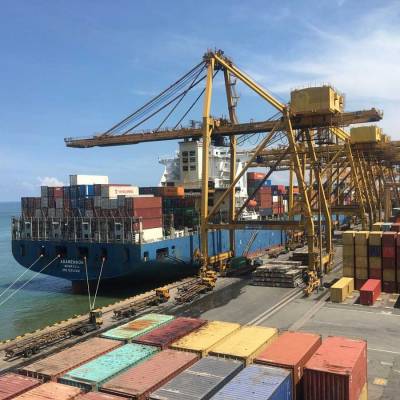- Home
- Infrastructure Transport
- PORTS & SHIPPING
- Look out for the opportunities, trends and current rental housing market dynamics in India

Look out for the opportunities, trends and current rental housing market dynamics in India
<span style="font-weight: bold;">Market to Thrive</span><br /> <span style="font-weight: bold;">ASHWINDER RAJ SINGH</span> sheds light on the current demand for rental homes and future trends that will drive the segment.<br /> <br /> The Indian real-estate market is going through exciting times: Sales have started picking up and the rental market is growing at a healthy rate too. A survey in 2009 pointed out that almost 35 per cent of urban families were living in rental homes; another survey in 2011 indicated that a massive 24.7 million families lived on rent. Since then, factoring in population growth, the development of new workplace hubs, the hugely increased rate of job creation and the formation of new residential precincts in and around our cities, the current demand for rental homes can well be imagined. <p></p> <p> <span style="font-weight: bold;">Current trends</span><br /> The reason for the massive growth in demand for rental housing in India is that buying a house is still a financial undertaking that is more or less out of reach for most of the population, owing to high property prices. Migration from villages and small towns to bigger cities has resulted in a constantly escalating housing requirement, but there are simply not enough housing projects that cater to the budgets of lower-income homebuyers. Naturally, they end up living in rented premises. Also, people require homes near their workplaces in the city that are also close to schools for their children. </p> <p>In contrast, renting a home within the city is still quite affordable, as rentals are just 1-3 per cent of the value of the property. Even if tenants have to rent a house on the peripheries of a major city, there are usually enough modes of travel available to connect them to their workplaces and good schools. </p> <p> Other trends supporting the growth of India's rental market are the effects of the demonetisation move late last year and the lull in the property market in the past couple of years. With properties on the resale market not finding enough buyers, owners are opting to rent out their properties instead. This has resulted in an oversupply situation on the market, and either stabilisation of rents or even declines in certain pockets. According to an independent survey, there was an average decline of about 7 per cent in annual rent in Delhi in the past year. </p> <p> <span style="font-weight: bold;">Future trends</span><br /> The Indian real-estate market is now showing significantly increased activity in terms of sales. However, the rental market will continue to thrive as buying a home is still not affordable to a vast majority of people and employment opportunities available in major cities are not proportional to housing available there. </p> <p> Also, comparing the expense of EMIs with rental outgo still tilts many people's decision in favour of renting. The upwardly mobile youth of today wants to stay in projects that offer the best amenities in locations that ensure good quality of life. Owning a home may not meet these requirements as one literally pays for everything that adds comfort and convenience - from location to project amenities - while renting means one can stay wherever one wishes, and move at any time. </p> <p> Today, a vast number of youngsters are deciding against buying a home and instead investing the funds that would have gone into EMIs into financial products for better returns, while staying in rented accommodation that does not pinch their pockets as much as an EMI does. Adding to this are the government's efforts to boost renting to help solve India's massive housing challenges. It is coming out with the National Urban Rental Housing Policy to help reduce the housing shortage and bring 11 million empty unsold houses onto the rental market. </p> <p> All in all, the rental market is poised for healthy growth. From the point of view of a property investor, buying a home to rent out is a sound decision as a steady rental income along with capital value appreciation of the property in the long term can make such an investment quite lucrative. </p> <p> <span style="font-weight: bold;">About the author: </span></p><span style="font-weight: bold;">Ashwinder Raj Singh is the CEO of ANAROCK Property Consultants.</span> <br /> <br /> <p></p> <p> <span style="font-weight: bold;">The Better Choice</span><br /> ANSHUMAN MAGAZINE highlights the opportunities for India's rental housing market.<br /> The housing segment in India constitutes a significant part of the real-estate and construction sector in terms of volume. Recognising the growing importance of this segment, the government has announced various policy initiatives and reforms to provide it a much-needed boost. </p> <p>The sector is already witnessing green shoots of revival as developers, end-users and investors embrace the changes these new policies are bringing in. Despite the market being subdued in the past few years, the demand for housing in India continues to grow. Traditionally considered a sound investment choice by generations, there is a growing population looking to rent homes within cities across India. The rapid urbanisation of our cities, increasing trend of nuclear families, growing employment opportunities and movement of students for higher studies to urban cities and surrounding suburbs present a great opportunity for rental housing. Another steady end-user base is that of expatriates and diplomats who come to live in cities for a short period of time based on their professional commitments. </p> <p>Rental housing offers a convenient and cost-effective option for all migrant populations who may not want to make a long-term financial commitment in a city. It is the most readily available option to the growing demand for housing in urbanising countries such as India. Renting a home emerges as a better choice for tenants across the income spectrum as it allows greater mobility and flexibility to the migrant population, especially in cities with high capital values. </p> <p>Realising the potential that the rental housing market has in India, a Task Force on Rental Housing was constituted by the Ministry of Housing and Urban Poverty Alleviation (MoHUPA), whose objective was to: </p> <p>Develop a strategic policy intervention to promote rental housing as a viable option. Create a legal and regulatory framework to enable private-sector participation in rental housing.</p> <p>Improve the financial attractiveness of rental housing.<br /> Based on the recommendations of the task force, a National Rental Housing Policy is currently under formulation. The vision of the policy is to enable the growth of rental housing in a holistic manner. </p> <p>The Draft Model Tenancy Act 2015, meanwhile, attempts to create a framework for the regulation of tenancy for commercial and residential properties. It tries to balance the rights and responsibilities of landlords and tenants alike through rental contracts; and aims for registration of rental contracts with the relevant authorities. </p> <p>The government is currently working towards the promotion of rental housing through such legislative support. The implementation of the policies surrounding rental housing will go a long way in promoting the segment while providing options for rental accommodation across urban spaces in the country.</p> <p> About the author: Anshuman Magazine is the Chairman, India and South East Asia, of CBRE.</p> <p> <span style="font-weight: bold;">Inching a New High </span><br /> MIR JAFFER ALI writes on the paradigm shift seen in the Indian rental housing market over the years.</p> <p> Buy vs Rent is a debate that never seems to reach a conclusion. While there are several schools of thought that support home ownership, skyrocketing property prices coupled with high interest rates act as major deterrents for people wanting to take the plunge. Moreover, considering the present market scenario, for denizens renting a property has evolved as a better option. </p> <p>A closer look at home ownership figures in India clearly suggests that rental demand is inching to a new high with every passing year. In fact, PropUrban's recently conducted survey validated that demand for rental properties has gone up substantially across metros as against previous years; 38 per cent of respondents stated that they preferred to rent a property rather than buy one. The primary reason cited was to live in prime locales and be closer to workplaces or schools and hospitals. Interestingly, with better employment opportunities, even Tier-II and Tier-III cities have embraced this trend. </p> <p>Buoyed by this rising demand for rental housing, it becomes imperative to understand the trends that are likely to define the rental realty space in 2017. </p> <p> Enhanced infra spurts demand in affordable rental markets<br /> With constantly improving connectivity and better reach of public transportation, it is no longer a challenge to travel to affordable rental destinations either in the peripheries or the suburbs. For instance, with the recently opened East-West Metro Corridor of Namma Metro (from Nayandahalli to Baiyappanahalli) in Bengaluru, travelling to several far-off places has become convenient. </p> <p> <span style="font-weight: bold;">Office spaces: Spillover demand</span><br /> With the development of key office spaces across metros, these markets command premium rentals. As a result, areas in the vicinity are seeing spillover demand from these office spaces. For instance, Sector 58 in Gurugram sees spillover demand from key office hubs at Golf Course Road. Similarly, in Bengaluru, Rachenahalli and Nagawara cater to the spillover demand from Manyata Tech Park and Kirloskar Tech Park. </p> <p> <span style="font-weight: bold;">Start-ups accelerate demand</span><br /> With an increasing number of start-ups across cities, the rental scenario of several micro-markets across metros is seeing an upward trajectory. In MMR, Powai has emerged as a major start-up hub, while in Bengaluru, markets like Indiranagar, Koramangala and HSR Layout are the prominent hubs for start-ups. </p> <p> <span style="font-weight: bold;">Pursuit for better lifestyle</span><br /> With increasing income levels, youngsters today aspire to a better lifestyle with high-end amenities. Thus, many choose to live in gated communities over relatively cheaper paying guest accommodation or single-unit homes.</p> <p> <span style="font-weight: bold;">Rise in rentals around schools</span><br /> Our survey revealed one interesting trend, where more than 50 per cent of respondents prefer to rent a place closer to their child's school as against their workplaces. Therefore, micro-markets in proximity to schools have recorded a growth in number of listings for rent over the last few years. For instance, in Bannerghatta Road in Bengaluru, a number of rental listings recorded a rise of about 14 per cent in just one year (H1 2016-H1 2017). Not to mention, these markets clock a rental yield to the tune of 3-4 per cent. </p> <p>Indeed, the rental market scenario in India has seen a paradigm shift over the past few years. However, it is also imperative to keep in mind the acute housing shortage in India and how rental housing can be a solution to this critical issue. The National Urban Rental Housing Policy 2017, which is currently awaiting the Union Cabinet's approval, will come as a huge respite for denizens. </p> <p> <span style="font-weight: bold;">About the author: Mir Jaffer Ali is the Founder & CEO of PropUrban.</span></p> <p> With consultants sharing a futuristic scenario, CW PROPERTY TODAY connects with builders and realtors to get a reality check on the growing demand for rental housing in India.</p> <p> <span style="font-weight: bold;">In the South<br /> T Chitty Babu, Chairman & CEO, Akshaya</span><br /> A massive section of India's population depends on rental homes for its housing needs. Existing and emerging pockets for rental housing are sprouting in every city with the vast majority of property owners preferring to rent out their property. With rising incomes, increased exposure to urban living standards and frequent overseas migration among people for employment, renting is the future of housing in India's metros. The share of rental homes in Tier-I and Tier-II cities are also in line to buck the trend. Several rental options are emerging today. Unlike earlier where single family rentals were on the rise, today there is a considerable increase in number of paying guests and shared model accommodations furnished with better facilities, developments, transportation and infrastructure. The trend is slowly adding up to a better real-estate environment and has given way for the rental housing market in India, throwing in some interesting similarities with other countries.</p> <p> <span style="font-weight: bold;">Shereena Anwar, LEED AP, Director, Malabar Developers</span><br /> The rental market is more prominent in metro cities but such a shift is observed in our projects too. It is clearly visible in our ready-to-move-in apartments - the option is not just for end-users but is also being considered by investors who find rental income lucrative. This has subsequently added to sales, where second homeowners are looking into a purchase to capitalise on the rental market. Speaking of strategies, we are working to grow our rental business and have initiated a service model called M 24, which includes services such as interior designing, insurance protection, landscaping, facility for organic farming, facilities for lease and rent of apartments, housekeeping, electric and plumbing services, facilities for shifting of residence, etc.</p> <p> <span style="font-weight: bold;">Farook Mahmood, Chairman & Managing Director, Silverline Realty, and World President, FIABCI-Paris</span><br /> The southern region of the country - Chennai, Hyderabad, Bengaluru and Kochi - has different priorities and a different price bandwidth. The preferences from clients are different too. But, overall, rental housing is stable. For the high end, it generates an RoI of 4-5.5 per cent. We receive about 30-35 per cent queries on rentals while 65-70 per cent will be sale, depending on the time of the year. In certain seasons it is higher; in others, lower. The rental market sees demand not only from millennials but a mixed range of age groups. Although housing for students is a major demand driver, a bulk of the business is from the corporate end, in terms of relocation from different cities and countries. They are the ones driving the boom. I see stability in the rental housing market going forward too. In Bengaluru, there is a standard appreciation of 15 per cent every three years or 5 per cent annually, depending upon how the lease is structured. It can go up to 20-25 per cent as well. And, 5 per cent is a fair rise in rental, so I see the market as stable.</p> <p> <span style="font-weight: bold;">In the West<br /> Rohit Gera, Managing Director, Gera Developments</span><br /> Rental housing in India is quite an informal sector. In the US, for instance, entire buildings are built to rent, and investors buy the entire building based on the rental that is churning and taking a cap rate. Rental housing in India is relegated to retail investors buying and renting out the property, who typically get a yield of about 3 per cent. Second, it depends on the location. For instance, our project in Kharadi near Pune has a high occupancy level because it is in the vicinity of workplaces and IT hubs. So, when this happens, and if there is enough civic infrastructure, the rents also go up. Currently, we are seeing one BHKs rented at about Rs 13,000 a month, while they are sold at Rs 27 lakh. This works out to nearly 6 per cent a year from the time they booked the apartment a year after having taken possession. This works out to be a good RoI.</p> <p> <span style="font-weight: bold;">Sneha Pathak, President, South MetroCity Association of Realtors (SMART), Mumbai </span>The boost for rental housing came last year after demonetisation. It is an open secret that a lot of transactions in apartments in Mumbai and other places in the country involved cash. So when demonetisation was announced, a lot of transactions were stalled; overall, there was a lot of uncertainty in the market about which way the rates were going to go. Most people thought rates would drop substantially after demonetisation and people who were to buy backed off. Therefore, the rental market picked up at that time and a lot of fresh rental demand was figured then. Also, in Mumbai, several professionals come from other towns and their first choice is obviously a rental home. This is an important driver for the rental market, particularly in new gated buildings with amenities. The third driver, sharing sheer economics, is that it is cheaper to rent than buy. With many months having gone by after demonetisation, we still have a healthy rental market. Out of 10 new clients that come to us, seven would be for renting and three for buying. Going forward, this market will be stable. Having said that, somewhere, Indians, unlike people in western countries, have a lot of emotional insecurity about not owning a home. We have seen a typical cycle with our clients in the past 15 years, wherein they take two rental homes; the third one will definitely be a home they buy to live in; and the fourth transaction will be to purchase a second home purely for investment. Now, this trend is slightly changing because the younger generation is a bit more open about it. The other problem about renting in India, especially in Mumbai, is that homeowners are not comfortable renting or leasing their place for the long term. So we typically end up doing a two-to-three-year agreement. Therefore, with the turnaround cycle being short, renters do not want to change their home every two to three years; so they end up buying a home. In the West, some people don't even own homes for their entire lifespan and are possibly always living on rent, but we do not see such a phenomenon working here.</p> <p> <span style="font-weight: bold;">In the north<br /> JS Brara, Proprietor, Skyline Estates, and Past President, Association of Certified </span>Realtors of India (ACRI), DelhiDriving the demand for rental housing is people coming to Delhi-NCR for employment. With budget restrictions, they prefer renting. Those with a good budget prefer Delhi, while those who want gated living conditions prefer Gurgaon and Noida. Accommodation is available in Noida and Gurgaon, while in South Delhi the availability is not much and rentals are on the higher side. In South Delhi, for instance, depending on the property, class B category rentals are Rs 30,000-40,000 for a two-BHK; for a three-BHK it is Rs 50,000-100,000. Going forward, I see the boom for rentals continuing, considering companies are expanding in both Gurgaon and Noida, which are IT hubs.</p> <p> <span style="font-weight: bold;">Tejinder Pal Setia, Chairman, Mona Townships</span><br /> In the tri-city of Chandigarh, Mohali and Panchkula, which are Tier-II and Tier-III cities, rental yields are low compared to the metros. If I am selling a flat of Rs 50 lakh, the rental yield is 2-3 per cent, which comes to a monthly rent of Rs 8,000-10,000. So, a person living in a three-BHK flat of Rs 50 lakh is paying Rs 10,000 as rent, whereas he can easily buy his own flat of Rs 35 lakh with an equal amount of EMI. So, considering the rental yield, rental housing is not in demand in these cities. For instance, if a builder is paying 10-11 per cent interest to banks, he will not be interested in renting out his flat at all, as it will be a yield of 2-3 per cent, which is a direct loss. Rather, he is more interested in clearing the inventory. However, for millennials who are constantly changing locations for job, it is good to rent out. Having said that, it is also a matter of supply and demand. In our region, there is an oversupply of low-cost housing; in future, affordable housing will boom and there will be a lot of inventory. Owing to this oversupply, we will see the rent falling even in metros in future.</p> <p> <span style="font-weight: bold;">In the east<br /> GK Sehgal, President, Realtors & Estate Consultants Association (RECA), Kolkata</span> In Kolkata, New Town and Rajarhaat have more apartments than demand, and these are easily available. Investors who have purchased homes want their places to be rented out. The rentals are reasonable too. Now, coming to areas such as Calcutta, Ballygunge and Alipore, these areas are already congested and the options are less. The rentals in these areas are quite high and the demand has been stable. A two-BHK flat, for instance, is not available for less than Rs 25,000-35,000, and a three-BHK can go anywhere between Rs 40,000 and Rs 100,000, if the apartment is big and attractive. A few years ago, the demand for rental homes used to be higher but now, gradually, rental demand is decreasing. Now, with loans easily available, people do not prefer renting because if you add maybe another 25-30 per cent to the rent, it becomes your EMI and you own the flat. So, the enquiries for sale are more than rentals. The sentiment of owning your house is still strong in India, in the younger generation too. And now, they are able to buy even more, with affordable housing coming in and incentives in terms of rebate in taxation. Going forward, if there is general demand for property, sales will increase and so will rentals; but rentals picking up faster than sales will not happen.</p> <p> <span style="font-weight: bold;">Harshavardhan Neotia, Chairman, Ambuja Neotia Group</span><br /> Rental housing is more popular in Tier-I and Tier-II cities as these have far greater avenues for those on transferable jobs or looking for job opportunities. This has created a good market for those seeking to invest in property for rental purposes as it ensures reasonable rentals along with property price appreciation. Our projects are reflective of this trend. As for growing our rental business, as our properties are ideally located and competitive in terms of quality and price, they enjoy a certain edge over other properties.</p> <p> Inputs from Seraphina D'souza</p> <p> To share your views on the Rental Housing market in India, write in at feedback@ConstructionWorld.in</p> <p></p>




















